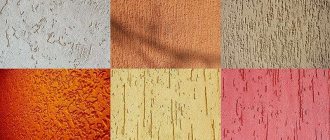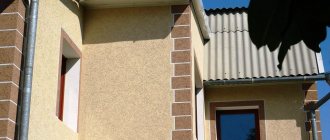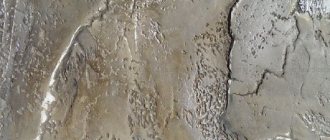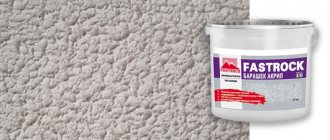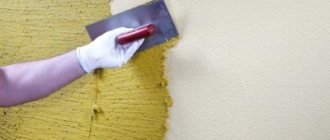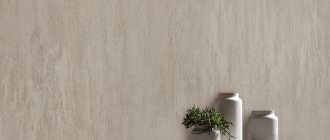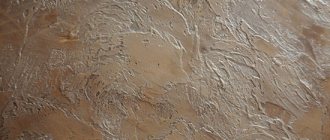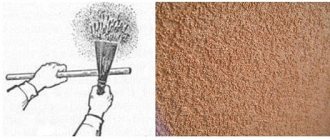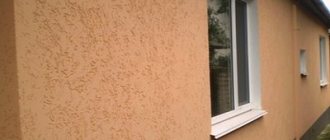What is decorative plaster Bark beetle
Bark beetle is a finishing coating for interior spaces and building facades. It got its name because of the original pattern, which looks like tree bark gnawed by small beetles.
Bark beetle is one of the most original and interesting options for decorative plaster.
It is supplied to the market in finished and powdered form. Shades from gray to pure white. In rare cases, the paste is tinted in different colors. The particles added to the composition give it its original texture. Their size varies from 1 to 5 millimeters. The average value is 25 mm.
Among the main advantages of the material:
- environmental friendliness;
- viscosity;
- light weight;
- resistance to mechanical stress;
- resistance to sunlight;
- high vapor permeability;
- wide scope of application;
- affordable price.
One of the main advantages of such plaster is its environmental friendliness.
Among the shortcomings, low maintainability is noted. If a piece breaks off, it is impossible to fix the situation unnoticed. It is also difficult to clean. Dust and dirt gets stuck in the narrow grooves of the pattern, where it is difficult to remove.
Bark beetle is a finishing coating. It involves applying a solution no thicker than the size of the granules included in the paste.
It is not recommended to use it to mask various defects: cracks, potholes, chips.
Bark beetle plaster – features and benefits
This plaster got its name because when applied it forms a pattern similar to the one left behind by bark beetles. This effect is achieved due to the inclusion of particles of different sizes in the mixture. Manufacturers have their own recipes for preparing plaster, but, as a rule, its main components are mineral chips, granite, marble or natural stone.
Bark beetle plaster is excellent for exterior decoration
The size of the granules usually varies from 0.1 to 3.5 mm, so depending on where you are going to apply the plaster - and it is used both indoors and outdoors - you need to pay special attention to the size of the granules. In the interior, preference should be given to small fractions, since such a pattern will not be very noticeable, but for the rear facade, a large pattern with a pronounced structure is preferable. Bark beetle can be found on sale in the form of a dry mixture and a ready-made composition.
The smaller the size of the granules, the higher the cost of the bark beetle.
Why is this composite plaster so popular? Firstly, the mixture is environmentally friendly, since it contains only harmless components. Secondly, it is available to any buyer due to its affordable price and wide selection of manufacturers. It is worth noting that plaster is not susceptible to mold infection and is not subject to atmospheric influences, since the temperature range of its use is quite wide - from –55°C to +60°C.
The applied composition after hardening has good anti-wear properties. The surface can be cleaned and wiped with a mild soap solution, which will not affect its appearance in any way. Bark beetle is a fire-resistant coating that does not emit harmful substances even when heated. The dry composition sold has, as a rule, a white-gray tint, to which a coloring pigment can be added at the application stage, or coloring can be done after application.
The finished mixture can be sold already tinted, so you can choose among the proposed color solutions. The mixture does not contain sand, so the prepared plaster is lightweight, which eliminates additional load on the surface. With the correct calculation of plaster per 1 m2, the coating will not only not shrink, but will also have excellent vapor permeability, which will allow the walls to breathe.
Factors affecting material consumption
The decorative mixture allows you to create an original design with a unique texture. Before installation, experts recommend making a design project that will create an idea of the final result and allow you to calculate how many bags will be needed for the entire room.
Manufacturers of finishing mixtures indicate average consumption on the packaging. However, this parameter is approximate.
Dependence of material consumption on grain size
Material consumption is affected by:
- release form;
- particle size;
- styling technique;
- quality of surface preparation;
- thickness.
The thicker the installation and the more complex the technique, the more plaster will be required for the entire surface. This rule also applies to particle size.
The finer the granules, the smoother the layer and the more economical the work is.
The final consumption of bark beetle plaster per 1 square meter is determined by many factors
Purpose
Mineral structural decorative plaster Prospectel “Bark beetle” is intended for application to surfaces as a decorative layer for interior and exterior decoration. Recommended as a finishing decorative layer in facade thermal insulation systems with external plaster layers.
Suitable for smooth bases made of concrete, cement, cement-lime, gypsum plasters, gypsum plasterboard, gypsum board sheets, etc. Not intended for the basement of building facades. Forms a thin-layer coating with a grooved texture for subsequent painting with facade water-dispersion paints.
Consumption per 1m2 depending on the type of bark beetle
Different types of decorative bark beetle plaster differ in composition. Manufacturers distinguish silicate, polymer-cement, acrylic and silicone pastes. Consumption directly depends on the type of material. This is due to differences in structure, plasticity, grain size, and the presence of additional components.
Polymer cement mixture
Polymer-based compositions are easy to apply. They are plastic, have good hiding power, and do not require special surface preparation. One of the significant advantages is vapor permeability.
The main advantages of using polymer-cement compositions are vapor permeability and ease of application.
When calculating, the type of walls and particle size are taken into account. If the granules are 2 millimeters in size, then about 3 kg will be required to finish the surface. With a grain of 4 millimeters - at least 5 kilograms.
Despite its high cost, polymer cement has excellent performance characteristics. The period of use is 10 years. The final cost additionally includes the price for dyes. The surface requires final tinting.
Disadvantages include instability to external factors. With sharp temperature fluctuations, cracking is possible.
Acrylic
Acrylic mixtures have proven themselves well for interior decoration. They are not used for working on the facade of a house. The main advantage of the solution is high elasticity, vapor permeability and cost-effectiveness.
The advantages of acrylic plaster are high elasticity and good cost-effectiveness.
To finish one square meter of prepared base, 3 kilograms of the mixture is enough. If the walls are poorly prepared, more composition may be required. The average service life of the coating is from 15 to 20 years.
Silicate
The silicate mixture is supplied to the market with different grain fractions. Depending on the size of the filler, the consumption of plaster varies:
- Fine filler. Grain no more than 2 millimeters. Consumption per 1 m2 does not exceed 4 kilograms.
- Coarse filler. The composition contains particles up to 3 millimeters. To finish a square meter, up to 5 kg of powder is required.
Silicate compounds are produced with filler granules of different sizes
Among the advantages of silicate solution are high elasticity, vapor permeability, and efficiency.
The composition can act as additional thermal insulation. It does not shrink and is resistant to cracking. Recommended for coating porous substrates (mineral slabs, gas silicate and cellular concrete).
Silicone
The main factors affecting the consumption of silicone mixture are the size of the granules and composition. With particles of 2 millimeters it does not exceed 3 kg, with granules of 4 mm - 5 kg.
High-quality leveling and priming of the base can reduce consumption. Silicone mixtures are elastic, easy to apply, and retain their performance characteristics for a long time. They have shown high efficiency in finishing walls made of cement, gypsum, concrete, foam blocks and aerated concrete blocks.
Silicone plaster is elastic and has a long service life
Learning to make a pattern on a bark beetle
Having found out how much bark beetle plaster we need per 1 m2, we move on to methods of applying drawings and patterns to the surface. Using a grater, we level the plaster: the character of the pattern depends on our movements.
If you make clear vertical movements, you get a rain pattern. In the case of direct horizontal movements of the tool, stripes will begin to appear.
The frosty pattern is created by wave-like movements of the hand. By rubbing the surface of the wall with a polystyrene foam trowel, you can make a “cork” if you move your hand in a circle using a small amplitude.
In 70–80 hours, the decorative bark beetle plaster will dry perfectly. Open windows and doors are absolutely excluded, as there should be no draft. After the surface has dried, apply varnish to the plastered walls or paint them in the desired color. The paint consumption is indicated on the can.
Wall application
Consumption per 1m2 depending on the manufacturer
The amount of finishing solution directly depends on the type of material and the size of the granules. However, the composition may differ between manufacturers. Accordingly, finishing costs will also be different. To evaluate them, you should carefully study the information about the product indicated on the packaging.
The consumption of decorative bark beetle plaster per 1m2, depending on the manufacturer, is as follows:
- Volma – 6.5 kg;
- Prospectors – 9 kg;
- Ceresite – 3 kg;
- Ceresit ct 35 Bark beetle – 4 kg;
- Knauf Rotband – up to 8 kg.
Ceresit silicone solutions have slightly higher consumption than polymer solutions. It can reach up to 5 kilograms per square meter. The increase is influenced by improper storage and dampness of the solution, temperature and humidity in the room during work.
Improper storage of silicone plaster can cause high consumption of finishing solution
Calculation method
For bark beetle plaster composition, the consumption is calculated depending on the characteristics of the surface and the total area. A sketch with measurements of the areas taking into account the piers is first made. Before work, it is necessary to determine the required volume of mixture per 1 m2 of wall. For “bark beetle” plaster, the calculation of material consumption differs from standard finishing mixtures due to the textured surface and dense granular composition.
First, measurements of the walls are taken and the working surface area is calculated. To decorate the facade of a building, it is recommended to choose plaster with large granules with a diameter of 2.5-3.5 mm. For indoor work, a mixture with small mineral particles of 0.8-2.5 mm is used.
In product instructions, manufacturers indicate standard material consumption. In accordance with the data, the total volume of the mixture for the object is calculated.
Bark beetle plaster composition from different manufacturers differs in consumption per 1 m2 depending on the recipe, composition, granule size, amount of water per volume of dry mixture. The average is 2.4-4 kg.
Taking into account the recommendations of different manufacturers, the volume of mixture per 1 m2 should be observed:
- Volma brand products - 6.5 kg per unit area is consumed;
- mixtures - you will need 8-9 kg;
- silicate-silicone plaster "Ceresit" with granules 2-3 mm - 3-4.5 kg;
- polymer-cement plaster composition of the Ceresit brand with fractions of 2.5-3.5 mm - 3-4 kg;
- silicone paste “Ceresit” with particles with a diameter of 2 mm - 3.5 kg;
- facade plaster mixture from the manufacturer Knauf Rotband - 8.5 kg;
- silicone plaster mixture Ceresit with granules with a diameter of more than 2 mm - 4.5 kg;
- acrylic plaster composition “Ceresit” - 3 kg.
Experts recommend purchasing products from trusted suppliers; the products must be of high quality for economical application. Poor quality materials are more expensive. When calculating the amount of mixture for a room, it is recommended to add another 10% to the resulting figure. Otherwise, you will need to purchase additional finishing material.
Consumption depending on grain size
The bark beetle is supplied to the market with different labeling. This indicator indicates the size of the filler particles. In most cases it can vary from 2 to 4 millimeters.
Before starting work, it is necessary to study in which cases which markings of the solution are tried on. Finely granular mortars are suitable for finishing interior walls. They provide a smoother and more decorative layer, are flexible and economical. Consumption is no more than 2.5 kilograms per 1m2.
Finely granulated solutions are used for interior wall decoration.
Coarse-grained mixtures with granules up to 4 millimeters are more expensive. To cover 1 square meter you will need up to 4 or more kilograms of dry powder. Such solutions are used in finishing the facades of buildings and structures.
The characteristics of some compositions are given in the table.
| Name | Granule size, mm | Consumption, kg/m2 | Color | Application temperature | Type of packaging |
| Color-Plast SK "Bark Beetle" | 1,5 | up to 2.8 | 56 basic colors + 2500 color shades Tikkurila MONICOLOR nova | From +5 to +30 degrees | Plastic bucket, 30 kg |
| 2,0 | up to 3.2 | ||||
| 3,0 | up to 4 | ||||
| Color-Plast Ssh “fur coat”, manual application | 0,5 | 1,8 | |||
| 1,0 | 2,3 | ||||
| 2,0 | 3,0 | ||||
| 3,0 | 4,0 | ||||
| 1,0 | 3,0 | ||||
| 2,0 | 4,0 | ||||
| Color-Plast L, manual application | 1,5 | 3,5 | 56 basic colors | ||
| 2,0 | 5,0 |
Bark beetle plaster: photo in the apartment
Many people still prefer to use other types of decorative plasters in their apartments, but it is definitely better to entrust their application to master finishers.
But even a home handyman who is not very experienced in such matters can apply bark beetle.
Especially if you use a few not very tricky techniques. One of them is the combination of types of bark beetle textures, the second is the color highlighting of individual architectural elements, and the third is the use of various techniques for painting surfaces on which the bark beetle is applied.
Let's look at these techniques in more detail:
1. After painting the plaster in the main color and drying it completely, prepare a thin composition of water-based paint slightly different from the main tone. Preferably: a little darker. It is applied with a fleecy roller to the surface in small portions and immediately rubbed with a plastic spatula for wallpapering. The tops of the texture are lighter in tone, and the valleys are darker.
2. After applying the base color and drying it, take a hard roller with a very short pile, after applying paint to it, carefully roll it out on the auxiliary surface, and then, without pressing, apply the new color only to the tops of the plaster layer.
3. Paint the plaster with glazes containing mother-of-pearl, glitter, etc.
4. Watch a short video and create a real masterpiece of wall decoration in your apartment for little money:
We recommend other articles on the topic
Polyurethane foam cleaner - how to wipe off hardened polyurethane foam
MDF panels for walls - variety of applications, subtleties of choice
Volma layer gypsum plaster - technical characteristics, instructions for use
Making wood concrete blocks with your own hands, wood concrete composition, proportions, mixing
How to save money
Savings are only possible when you understand what influences the increase in consumption.
The main parameters influencing the cost of the solution are:
- layer thickness;
- application technology;
- grain size;
- quality of base preparation.
The consumption of decorative mortar depends on the thickness of the layer applied to the walls
If the first 3 parameters cannot be changed, then it is possible to save significantly on the last one. Porous walls actively absorb moisture and increase the consumption of decorative mixtures. Therefore, all surfaces must be carefully prepared.
It is important to measure elevation differences and level them out as much as possible. The smooth surface allows you to apply a minimum thickness of the plaster layer.
To minimize absorption, the base is primed with deep penetration compounds. They create a polymer film that prevents water from entering the walls from the plaster. Thanks to this, the finish adheres more firmly.
To reduce solution costs, the surface must be leveled
The last rule of saving is careful calculation. You should calculate in advance the amount of material required. For finishing it is purchased with a small reserve. It should not exceed 10-15% of the calculated value.
What affects paint consumption?
We have already become familiar with the influence of the base on the consumption of decorative coatings. Now let’s look at what characteristics of the composition itself affect its consumption. This will allow you to avoid the tricks of manufacturers interested in high consumption of their goods.
- Water absorption coefficient. Its average value is 0.05 kg/sq.m. The higher this indicator, the higher the consumption of the paint composition. The lower, the more resistant the coating is to water.
- Type of binder. The maximum consumption is for the cement composition. The consumption of façade acrylic paint is minimal.
- Amount of binder. There is a direct relationship here - the more binder in the composition, the thicker the composition, and the greater its consumption.
- Presence of polymer fibers. They are added to thicken facade paints. Thanks to them, small cracks, up to 0.5 mm, are well masked. The higher their content, the thicker the composition and the greater its consumption.
We recommend: Do-it-yourself foundation for a fence made of corrugated sheets
Uneven surfaces also increase paint consumption.
Methods and examples of flow calculation
A preliminary calculation allows you to estimate the volume of packaging required per room. First, study the base - if it is flat, then the thickness of the coating will be minimal.
The smooth surface allows you to apply a minimum thickness of the plaster layer
Consumption is estimated using the formula: A*B*C, where A is the average consumption of the mixture per 1 m2, B is the surface area for application, C is a layer of plaster 1 centimeter thick. To finish 19 square meters, with a consumption of 6 kg, you will need 6 * 19 * 1 = 114 kilograms. Most manufacturers pack 25 kg bags. The final value will be 4.56 bags. Masters recommend taking with a margin of 10-15%. Therefore, in this case, at least 5 bags will be required.
If the base has differences, control measurements are taken at several points. Their values are added and divided by the quantity. The average layer thickness is obtained. With differences of 3, 6 and 7 cm, the average layer thickness will be at least (3+6+7)/3=5.4 centimeters. Further, to calculate the bark beetle plaster, similar operations are carried out as indicated above.
Calculation of the amount of mixture
In addition to purely technical (grain size in plaster) or physical characteristics (surface area to be treated), material consumption can be affected by:
- preliminary preparation of the wall (roughness, unevenness, etc.);
- place of work: for external work, in any case, the consumption will be greater than for internal work;
- qualification of the craftsman - an experienced craftsman will minimize unproductive losses: rework, remains of the mixture in the container, the solution falling to the ground, etc.;
- operating conditions: how close the building is to roads, how dusty the area is, weather conditions. An unfavorable climate requires more plaster consumption.
Thus, to calculate the amount of materials you need to take into account:
- expected thickness of the plaster layer. A layer that is too thick cannot be pressed through to obtain a pattern, so keep it to a minimum;
- surface area - do not forget to take into account all corners, niches and relief if this is a building of complex architecture;
- builder's skill.
After this, we add another 10% to the received quantity - the usual reserve for unforeseen difficulties. Since almost all companies produce mixtures in 25 kg packages, special accuracy is not required in calculations.
Facade paints and their consumption
Most Bark Beetle finishing plasters are supplied to the market in white. In rare cases they are already tinted. They can be given a tint by introducing a color pigment into a ready-made solution for plastering walls or covering them with façade paint.
You can give the decorative solution the desired color using coloring pigments.
Painting after complete drying of the finish showed high efficiency. For work, craftsmen use a soft roller without strong pressure. This technique allows you to avoid painting the depressions, which gives the surface a three-dimensional volume.
The following paints showed high efficiency:
- acrylic;
- alkyd;
- silicate;
- silicone;
- oil
When using acrylic materials per square meter, up to 200 grams in 2 layers is required. The paints are suitable for finishing interior rooms. When working with facades, dyes that are resistant to external factors are selected.
When tinting the surface with acrylic paint in 2 layers, you will need 200 g per 1 m2
For silicone and silicate paints, consumption ranges from 300 to 400 grams per 1 m2 with double application. Oil pigments are the most economical, but they are vapor permeable and easy to ignite.
The technical specifications indicated on the product packaging allow you to calculate how much dye is needed to tint the walls. To calculate, multiply the indicator on the packaging by the wall area and the number of layers.
Painting the walls
Having figured out which paints are best suited and having assessed the scale of the entire action, you can safely proceed to the first stage of repair work. The variety of colors is limitless
Surface preparation
In any façade work, it is very important to properly prepare the surface, with the exception of ventilated systems.
- If the walls are made of concrete, the most important thing is to clean it from dirt and dust. After which it is necessary to seal all the holes and cracks and allow to dry.
- It’s the same with the plastered surface of facades; the main thing is to keep the surface clean and dry - then the paint will adhere better.
- When working with a facade that has already been painted, you should remove all the old facade finishing by stripping and sanding: paint does not adhere well to paint.
- When painting metal elements, be sure to remove traces of rust, even barely noticeable ones.
- After everything is cleaned and puttied, the surface is primed.
Note!
Corrosion, fungi, rust and mold significantly increase the consumption of acrylic facade paint, since in contaminated areas it will more often crack and peel, requiring repair.
Finishing work
When starting to directly apply paint to the surface, you should take into account several nuances that may affect the result:
- The ambient temperature should not be below 5 degrees.
- It is not advisable to carry out work after rain, or you will have to wash it and wait until the surface dries.
- You need to purchase a new brush or roller; working with a tool that has already been in contact with paint is contrary to the norm. The photo below shows a conveniently used roller.
Roller on an extended handle Expert advice:
- The layers must be applied perpendicular to each other: if the first layer of paint was applied horizontally, then the second should be vertical.
- You should wait until the first layer dries, otherwise the paint may wrinkle.
- Try to avoid windy days, which raise dust into the air, which, in turn, settles on the facing material.
Painting instructions:
- Start work from the top of the facade so that the fresh paint does not run off onto the already drying layer.
- After dipping the roller into the container with paint, slowly begin to move it across the surface, lightly pressing on the base.
Special container for paint
- It is better to use a wide brush to cover a larger area at a time.
- After applying the paint, evaluate the result; if it is visible in some places, you will have to apply a third layer.
Use several types of brushes: for joints, corners and other facade elements
Important!
In this situation, the material consumption will increase: you will either have to buy more or leave it as it is.
Preparing the surface for work
After purchasing materials, they proceed to preparatory operations. The final result directly depends on the quality of the walls. Work order:
| 1. Surfaces are thoroughly cleaned of old coating. Remove existing dirt, construction bolts, and other defects. If there are cracks, they are cleaned out. | |
| 2. If signs of fungus or mold are found, they are cleaned as much as possible, and the detection areas are treated with antiseptics. | |
| 3. Then apply deep penetration primer. | |
| 4. If the difference is more than 2-3 millimeters per square meter, then preliminary leveling is done. The solution is used to seal cracks and irregularities. If local bulges are present, they are cut off with a grinder. | |
| 5. The leveled surface is re-primed. |
According to experts, the permissible difference should not exceed 1 millimeter. When the preparatory stage is completed, they begin to knead the material and apply it.
Typical errors when applying the mixture
Bark beetle is a decorative plaster that is quite easy to work with even for a beginner. However, violation of the application technique and preparation conditions can lead to poor-quality results and peeling of the material.
Experts identify 2 mistakes that are often made when working with material:
- Poor preparation of the base. Insufficient quality of removal of the old coating and neglect of the primer lead to the fact that the new coating does not adhere well. The solution consumption increases. After drying, cracks appear or the composition peels off the walls. This is due to the different reactions of types of finishes that differ in composition to temperature changes.
- Temperature violation. It is recommended to apply the mixture at temperatures not lower than +7 and not higher than +30 degrees. In other conditions, the room should be heated or, conversely, cooled. The composition should dry without direct exposure to sunlight. Average temperature 20 degrees. The use of heating devices or fans when drying is not allowed. This leads to disruption of technology.
It is allowed to carry out plastering work at temperatures from +7 to +30 ⁰С
The result can also be affected by too thick a layer, incorrect application, or violation of storage conditions for the undiluted composition.
Calculating the amount of plaster is an important stage of preparatory work. It allows you to calculate and prepare the required volume of the mixture in advance. To correctly determine the volume, it is necessary to take into account the thickness of the applied layer, the quality of preparation of the base, the type of solution and the size of the granules in it. On average, costs range from 3 to 4 kilograms per square meter.
Bark beetle plaster: application technology
There are several rules that will help you apply bark beetle plaster with your own hands correctly, easily and economically.
- According to the technology, before applying the composition, the surface is primed with a special primer for bark beetles containing quartz flour. Or you can add it to the deep penetration primer yourself.
2. It is necessary to use a special tool to work with this plaster.
You will need: a metal steel rectangular trowel, otherwise called a “Venetian”, a spatula 60 - 80 mm wide and a plastic grater.
The material is applied with a Venetian and at the final stage the plaster is grouted. Using a spatula, it is convenient to apply the composition to the trowel and remove the remaining milk from it - grain-free plaster. They also use it to remove milk from the surface of the grater. And the grater forms a pattern by rolling the grains, which have a rounded shape, over the freshly applied material.
3. The amount of material applied to the wall determines the grain size in it. You cannot apply a layer thicker than the grain fraction, otherwise the desired effect will not be achieved. To do this, the trowel is held at an angle of approximately 35° (±15°) during application. The remaining material on it that does not contain grains is removed during the application process, and a new portion of the composition is applied to the cleaned trowel.
4. The texture is formed 8 - 10 minutes after application to the wall. Therefore, it is better to do the work together so that the process is continuous. It is better to plaster a separate wall in one step, without interruption in work, in order to avoid making joints.
5. Constantly remove milk from the grater that accumulates on it while forming the texture.
6. Grout with a Venetian trowel after the material has completely set, but before it dries completely, using light movements without pressure, repeating the movements of the trowel when creating the texture. At the same time, the topmost layer of plaster is compacted and glossed. And here is the result:
All these technological rules apply to the 3 most commonly performed types of bark beetle plaster textures:
- rain or its variety - horizontal stripes;
- birch - texture, with mutually perpendicular strokes;
- classic bark beetle - an imitation of wood affected by the beetle of the same name.
The photo shows the movements of the grater that form these types of textures.
The share of obtaining the birch tree texture, the first 2 movements are combined.
We offer video instructions on how to apply bark beetle plaster to obtain different textures:
Don't forget about the grain fraction. Fine-grained bark beetle applied to a wall painted before priming will give the same texture as rain.
There are other, less frequently used methods of applying and forming the texture of bark beetle plaster.
The first option is obtained by applying a Venetian trowel to a freshly applied layer of bark beetle (unstuck): the trowel pressed against it abruptly comes off on itself. Or fresh plaster is rolled with a roller with a large pile. In this case, the main texture is formed by the liquid fraction of the plaster, and the grains enhance the 3D effect.
This option is obtained by applying bark beetle using a Hopper plaster gun attached to a compressor.
When working with cement bark beetle, some craftsmen add 5–7% dispersed PVA to it. It becomes more elastic and acquires additional water-repellent properties.
This video will help you figure out cases where you cannot avoid joining bark beetle plaster:
It remains to add that you should work with plaster from +5°C to +25°C. At a higher temperature, the composition will dry out too quickly, which will interfere with the normal formation of texture.
